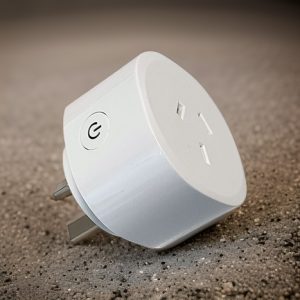How to Include the Ness Z-Wave Smart Plug into a Z-Wave Network –
To seamlessly integrate your Ness Z-Wave Smart Plug into a Z-Wave network, follow the steps outlined below. This process ensures that each device is correctly added and fully functional within your system. By following these instructions, you can efficiently manage and customise your devices for optimal performance.
To include the Smart Plug into a Z-Wave network as a non-security and security device:
- Connect the power supply
- Set the Z-Wave network main controller into learning mode (see Z-Wave network controller operating manual).
- Triple click the Z-Button, and the LED indicator will flash 3 times in blue. The Smart plug should be recognised and included in the Z-Wave network.
To include the Z-Wave Smart Plug into a Z-Wave network in SmartStart mode:
- Scan the QR code on your device, and add the device DSK to the main controller.
- Power the Smart Plug on.
- LED will blink in blue 3 times, and enter SmartStart. If the add is successful, the LED will be off, then the Z-Wave PC Controller interface will display the corresponding device information.
How to Exclude the Ness Z-Wave LED Bulb out of a Z-Wave Network –
To effectively remove a 2-Wave device from a Z-Wave network, follow these steps to ensure
smooth operation and maintain system integrity. This process guarantees the device is correctly disconnected and ready for reconfiguration or replacement, allowing you to manage and
customise your smart home setup with ease.
To remove the LED Bulb from the Z-Wave network:
- Insert the Z-Wave Smart Plug into a socket.
- Set the Z-Wave network controller into the exclusion mode.
- Triple click the Z-Wave button.
- LED will blink in blue 3 times, and then start slow flashing to indicate that the exclusion is successful. The LED will indicate network status after it is removed from the Z-Wave network.
Association –
The Z-Wave Smart Plug only supports one association group.
| Grouping Identifier | Max Nodes | Send Commands |
| Group 1 | 0x05 | 1. Basic Report 2. Meter Report 3. Device Reset Locally Notification |
Advanced Configuration –
The Z-Wave Smart Plug offers a wide variety of advanced configuration settings. The Below parameters can be accessed from the main controller configuration interface.
- Parameter No. 20 Overload protection
The Z-Wave Smart Plug keeps detecting load power, once the AC current exceeds 11.5A for more than 5s, the Z-Wave Smart Plug’s relay will turn off.
0 – The function is disabled.
1 – The function is enabled.
Default setting: 1
Parameter size: 1 (byte)
- Parameter No. 21 Setting device status after power failure.
Define how the Z-Wave Smart Plug reacts after the power supply is back on.
0 – The Z-Wave Smart Plug memorises its state after a power failure.
1 – The Z-Wave Smart Plug does not memorise its state after a power failure. The connected device will be on after the power supply is reconnected.
2 – the Z-Wave Smart Plug does not memorise its state after a power failure. The connected device will be off after the power supply is reconnected.
Default setting: 0
Parameter size: 1 (byte)
- Parameter No. 24 Notification when Load status changes
The Z-Wave Smart Plug can send notifications to the association device (Group lifeline) when the state of the Z-Wave Smart Plug’s load changes.
0 – The function is disabled.
1 – Send Basic report.
2 – Send Basic report only when Load condition is not changed by Z-Wave Command.
Default setting: 1
Parameter size: 1 (byte)
- Parameter No. 27 indicator modes
After smart plug being included into a Z-Wave network, the RGB LED indicator will indicate the situation of load.
0 – The indicator light remains the same as the load on/off status. When the load is on, the light is on, and when the load is off, the light is off.
1 – Within 5 seconds after the operation loan, the indicator light is consistent with the load on/off status, and then the indicator is off.
Default setting: 0
Parameter size: 1 (byte)
